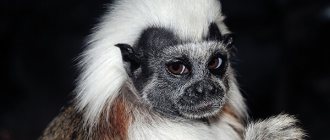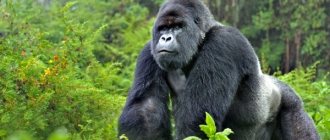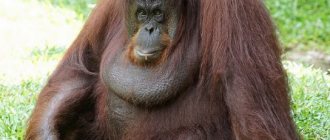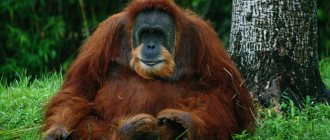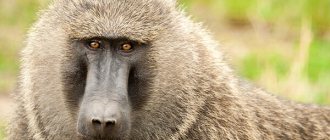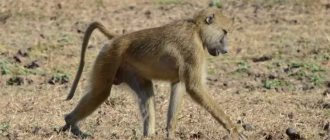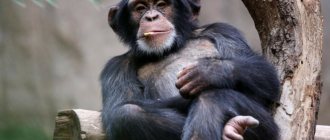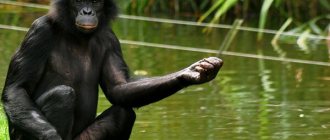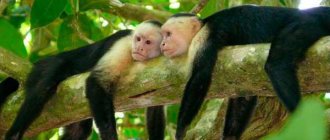Habitat
Saimiri monkeys inhabit the tropical forests of Peru, Costa Rica, Bolivia, and Paraguay. South America is suitable for its climate and cool thickets, the availability of food for these animals. The Saimiri do not inhabit only the high mountainous regions of the Andes. In general, they do not like mountainous areas, since it is more difficult for them to hide from predators there.
You can see these monkeys near Brazilian coffee plantations. To the south of Paraguay, a different climate zone begins, and the number of Saimiri monkeys decreases significantly. These animals prefer to choose places near bodies of water, although they almost always live in trees. They also need water, both in its pure form and for providing growth to the plants that saimiri feed on.
Appearance
Saimiri belong to the prehensile-tailed or squirrel monkeys, from the genus of broad-nosed monkeys, like capuchins. Saimiri are a little more than 30 centimeters long and weigh about one kilogram. Their tail is long, longer than the body (sometimes more than 0.5 meters). But unlike other primates, it does not perform the functions of a fifth hand, but serves only as a balancer.
The coat is short, the back is dark olive or gray-green, the paws are red. The black saimiri has darker fur - black or dark gray. The muzzle is very funny - there are white circles around the eyes, white ears. The mouth, on the contrary, is dark in color, and because of this strange contrast, the monkey was called a “death’s head.”
But in fact, as can be seen from many photos of saimiri , this big-eyed primate is very cute. Despite the fact that the animal's brain weighs 1/17 of the weight of the entire body, and is the largest (in accordance with body weight) among primates, the organ is designed in such a way that it has no convolutions.
Lifestyle
The smallest groups of monkeys number about 50-70 individuals, but the denser and more impenetrable the forest, the larger their flock. For example, in Brazil, saimiri live in 300-400 individuals. Most often, one alpha male becomes the main one in a pack, but there are also several of them. These privileged primates have the right to choose their mate, but the rest must try very hard for this.
It happens that the pack breaks up into different groups when there is a conflict between the alpha males, or simply one part wants to stay in the chosen territory, and the other wants to move on. But it happens that the community gathered again and lived together. Saimiri are very agile tree climbers, jumping from branch to branch.
Even a female with a baby on her back can jump a distance of up to 5 meters. They live in groups, constantly scouring branches and grass in search of food. In nature, they blend so well with the trees that a motionless animal cannot be noticed even from a distance of several meters.
The activity of saimiri occurs during the daytime; they are constantly on the move. At night, the monkeys hide on the tops of palm trees, where they feel safe. In general, safety for primates of this species comes first; accordingly, they are very timid.
At night they freeze, afraid to move, and during the day they run away from any, even imaginary, danger. One of the monkeys of the herd, frightened, emits a piercing cry, to which the entire herd reacts by immediately fleeing. They try to keep up with each other, stay close together, during the day they constantly call out to their comrades, communicating with chirping sounds.
Monkey room
Whatever breed of macaque you buy, it must be kept in a cage or enclosure. To do this, you can fence off part of the room for her. When you let the monkey out to walk around the room or apartment, you need to keep a vigilant watch over it, otherwise the mischief maker may tear and ruin things and books. If she comes across an aquarium on her way, it is likely that the pet will want to feast on snails and fish that she catches from it.
Features of saimiri
Saimiri monkeys really do not like lowering temperatures and climate change. Even in their homeland they do not live in steppe regions. The climate of Europe is not suitable for them, so even in zoos they can be seen very rarely. Monkeys really need warmth, and in nature they warm themselves by wrapping their long tail around their necks or hugging their neighbors.
Sometimes saimiri form balls of 10-12 individuals, all in search of warmth. Monkeys are very often worried, scared, and at such moments tears appear in their large eyes. Although these animals are quite easy to tame, especially if they were bred in captivity and initially know a person, you will still rarely encounter them in private homes.
The price of saimiri is quite high - 80,000-120,000 thousand. But this is not the most important indicator that not everyone is ready to support them. Their main unpleasant feature is that they are very untidy; when eating, they squeeze the fruit and splash the juice.
It is especially unpleasant that they rub the tip of their tail with urine, so it is almost always wet. In addition, saimiri love to complain and squeal, both in a huge forest and in an apartment. The intelligence of monkeys allows them to be toilet trained. They do not like to bathe, but they need to be washed more often.
Natural enemies
Despite their innate caution, saimiri are not always able to escape from their pursuers, and there are quite a few of them in nature.
Natural enemies include:
- tree anaconda and harpy;
- boas (dog-headed, common and emerald);
- jaguar and jaguarundi;
- ocelot and feral cats;
- Human.
Return to content
Nutrition
Saimiri feed on fruits, nuts, snails, insects, bird eggs and their chicks, and various small animals. So, we can say that their diet is quite varied. When kept in captivity, the monkey can be fed with special food, which is offered by some manufacturers.
Additionally, you need to give fruits, juices, various vegetables, dairy products (yogurt, cottage cheese, yoghurts), and some greens. For meat foods, you can offer small pieces of boiled meat, fish or shrimp. They love eggs, which can be given boiled, or small raw quail eggs.
Saimiri and banana
They will be very grateful if you offer them a large cockroach or locust for lunch. Be sure to give citrus fruits among other fruits. Fatty, salty and peppery foods are prohibited. In general, the Saimiri diet is similar to proper human nutrition.
Monkey in the house: nuances
How long monkeys live at home depends on proper care for them, and for this you need to know where to keep them, how to care for them, how to walk, feed and treat them.
Where to keep it?
Monkeys must be kept in a cage. You must choose a cage that is spacious but durable so that the animal cannot get out on its own. Place a tray at the bottom and pour sawdust or sand into it.
To prevent your pet from getting bored, you can attach a mirror to the cage. Inside the cage you can place a house with a blanket and a branch for acrobatic exercises.
Make sure that objects that are dangerous to the monkey's life are in hard-to-reach places if he suddenly gets out of the cage.
The temperature in the room where primates are kept must not be lower than +22 °C. They need sunlight for normal development.
How to care?
First of all, you need to clean the animal’s cage every day, and completely change the filler at least once a week, otherwise an unpleasant odor cannot be avoided. When letting the monkey out of the cage, make sure that it does not hide food anywhere; rotting food is not the most pleasant aroma in the house.
The animal can be put on a disposable diaper, like a child, which is changed twice a day. The diaper should be removed at night to avoid diaper rash. Many trainers teach monkeys to go to the toilet.
Domestic monkeys should be bathed twice a day and then dried well to prevent them from catching a cold.
They should be treated kindly, but if they have done something wrong - strictly. You should not shout, hit or swing your arms - this can cause aggression.
When and how long to walk?
You can let the monkey out for a couple of hours to run around the apartment, but do not provide absolute freedom, keep it under control, otherwise the apartment will look like after a hurricane, and the animal may get hurt or burned.
In order to catch it later, it is advisable to have a special device - a net. In the summer, the monkey can be taken out to the countryside by placing it in a spacious enclosure.
If you teach your monkey to walk on a leash, you can take him outside for short periods in warm weather, when there are no dogs or loud noises.
What to feed?
What to include in your pet’s diet depends on its breed. Monkeys mostly eat vegetarian food, but there are exceptions. Thus, rhesus monkeys will not refuse insects, small animals or lizards.
Capuchins happily eat caterpillars, ants, eggs, larvae, small frogs, lizards, and small birds. Saimiri loves insects and small birds.
The food should be varied and must include sweet fruits, vegetables, and sometimes boiled chicken or turkey. Baby monkeys are fed infant formula.
You can also use commercially available special monkey food. The cage must have a drinking bowl with fresh water.
Important! You should not feed monkeys cockroaches, newly born mice, raw or smoked meat, spicy or salty foods.
How to treat?
First of all, you should pay attention to the presence of common parasites: worms, fleas, ticks. A veterinarian can prescribe treatment in each specific case. Modern medicine has developed a whole arsenal of methods to combat parasites.
Primates can catch a cold if the temperature is not maintained, contract pneumonia, and dysentery.
Treatment should be prescribed by a veterinarian, preferably if he specializes in primates.
Reproduction
Females reach sexual maturity at 2.5-3 years, males only at 5-6 years. The breeding season can occur at any time of the year. At this time, the alpha male becomes larger and much more aggressive. Females carry a pregnancy for about 6 months.
Saimiri cub
A born saimiri calf almost always sleeps for the first 2-3 weeks of life, holding tightly to its mother’s fur. Then he begins to look around and try adult food. Kids are very playful and are constantly on the move. In captivity, monkeys live for about 12-15 years.
In the wild, due to the large number of enemies, few individuals can live up to this figure. The natives of the tropical forests nicknamed this monkey “death's head”, and imagined a demon whom they feared. Over time, this mystical glory of hers evaporated, and only a formidable nickname remained.
